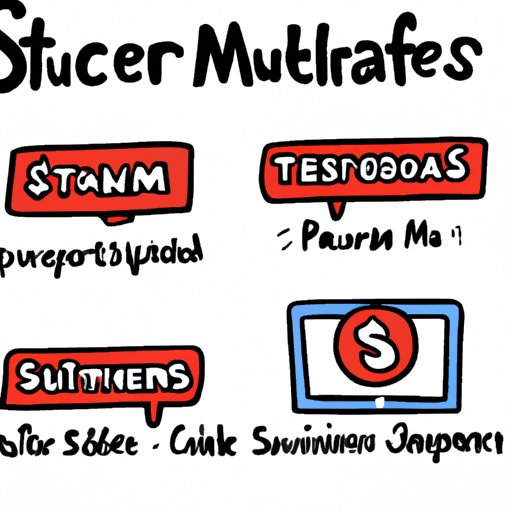
How YouTubers Make Money: Exploring Different Income Streams
YouTube has taken the world by storm, with millions of creators across the globe using the platform to create and share content. But have you ever wondered how these YouTubers make a living? From ad revenue to merchandise sales and sponsorships, there are several ways in which YouTubers can earn money. In this article, we’ll explore the various income streams available to YouTubers and how they leverage these to earn a living.
Ad Revenue
One of the most popular ways YouTubers make money is through ads that appear on their videos. When a viewer watches a video and an ad plays, the YouTuber earns a percentage of the ad revenue. This amount varies depending on factors such as the length of the ad, the viewer’s location, and the advertiser’s bid.
YouTubers must meet certain requirements to earn money through ads. They must have at least 1,000 subscribers and 4,000 watch hours. Additionally, their content must comply with YouTube’s terms of service and community guidelines.
Some YouTubers who earn significant income through ad revenue include PewDiePie, Shane Dawson, and Zoella. PewDiePie, for example, earns millions of dollars each year from ads that run on his videos.
Sponsorships and Brand Deals
Sponsorships and brand deals refer to agreements between YouTubers and companies who pay them to promote their products or services. These deals can range from paid placements within a video to sponsored posts on social media.
To land sponsorships or brand deals, YouTubers must have a large following and a niche audience that aligns with the interested company’s target market. Brands often seek out YouTubers who align with their values, and YouTubers who are authentic and trustworthy.
Some YouTubers who have successful sponsorship deals include David Dobrik, Lilly Singh, and Casey Neistat. David Dobrik, for example, has partnerships with several brands, including SeatGeek, Dollar Shave Club, and Honey.
Merchandise Sales
YouTubers can sell merchandise to their fans, including t-shirts, hats, and other accessories. This is a popular income stream for creators who have built loyal fan bases.
YouTubers often collaborate with companies that specialize in creating merchandise such as Crowdmade, Teespring, and Merch by Amazon. They design the products and then promote them to viewers through their channels and social media.
Some successful YouTubers who sell merchandise include Miranda Sings, Shane Dawson, and Ryan Higa. Miranda Sings, for example, sells a range of merchandise, including t-shirts, socks, and iPhone cases.
Affiliate Marketing
Affiliate marketing refers to a commission-based income stream where YouTubers earn money by promoting other people’s products or services through affiliate links. When a viewer clicks on the link and makes a purchase, the YouTuber earns a percentage of the sale.
To earn money through affiliate marketing, YouTubers must build trust with their audience and only promote products or services that they believe in. They must also disclose the use of affiliate links to their audience to maintain transparency.
Some YouTubers who earn income from affiliate marketing include Jeffree Star, Emma Chamberlain, and Tati Westbrook. Jeffree Star, for example, promotes affiliate links for makeup and beauty products on his channel.
SuperChat and SuperStickers
SuperChat and SuperStickers are features on YouTube that allow viewers to pay for special attention during a live chat. When a viewer uses SuperChat or SuperStickers, their message can be highlighted or displayed prominently in the chat.
YouTubers who enable these features can earn money from viewer donations. They may also use SuperChat and SuperStickers during live streams to engage with their viewers and offer exclusive content or shoutouts in exchange for donations.
Some YouTubers who utilize these features successfully include PewDiePie, Dan and Phil, and Jacksepticeye. PewDiePie, for example, offers shoutouts and acknowledgments during his live streams to viewers who use SuperChat.
Fan Funding or Donations
Fan funding or donations refer to voluntary contributions made by viewers to support their favorite creators. YouTubers can receive donations through platforms such as Patreon, Ko-fi, and PayPal.
YouTubers who offer exclusive content, early access, or behind-the-scenes footage often receive more donations from their fans. They may also run fundraising campaigns to support specific projects or to give back to their communities.
Some YouTubers who successfully receive donations from fans include Philip DeFranco, Jenna Marbles, and MrBeast. MrBeast, for example, recently raised over $20 million for his #TeamTrees campaign, which aimed to plant 20 million trees.
Consulting and Speaking Gigs
YouTubers who have established themselves as experts in their niche can leverage their popularity to earn consulting or speaking engagements. They may be asked to speak at events, consult for companies, or create educational content for other creators.
To land consulting or speaking gigs, YouTubers should build a robust portfolio of their work, establish themselves as thought leaders, and network with industry professionals.
Some YouTubers who have successfully landed consulting or speaking gigs include Matt D’Avella, Casey Neistat, and Marques Brownlee. Casey Neistat, for example, has spoken at several conferences and has consulted for companies such as Nike and Google.
Conclusion
In conclusion, there are several ways YouTubers can earn money. From ad revenue to sponsorships and brand deals, merchandise sales, affiliate marketing, SuperChat and SuperStickers, fan funding or donations, and consulting and speaking gigs. By understanding the various income streams available to YouTubers, creators can better tailor their content, engage with their audience and build profitable businesses.
Whether you are a content creator or you’re just curious about how YouTubers make a living, understanding these income streams is an important step in appreciating the effort and time that goes into creating great content.




